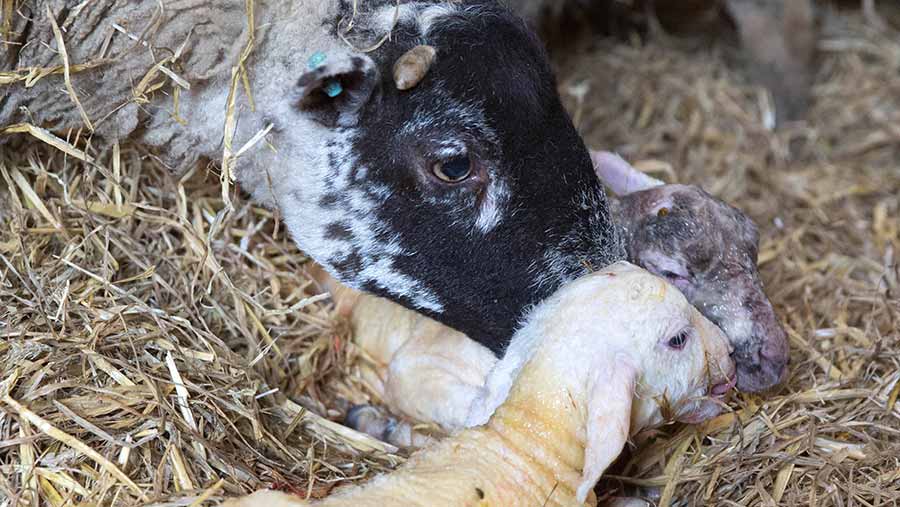How sheep colostrum trials are helping to reduce antibiotic use
 © Tim Scrivener
© Tim Scrivener Trials are comparing two lamb blood tests in a bid to reduce antibiotics use on farms through optimising ewe nutrition and health.
A series of farm studies has compared refractometer tests and zinc turbidity tests (ZSTs) for measuring protein levels in newborn lamb blood samples.
See also: More sheep industry news
Currently costing about £3-£4/sample, ZSTs on blood from two-day-old lambs give farms an insight into late-gestation ewe nutrition and whether lambs are sucking and absorbing colostrum.
Refractometer testing uses equipment many veterinarians involved in dairy work will have and yields results on the same day, while ZSTs can take 24 hours and needs delivering to a veterinary investigation or commercial laboratory.
Optimum blood sampling
“We think the best time to sample lamb blood is two to four days after lambing,” says independent sheep consultant Kate Hovers, who is conducting a trial with veterinarians in north Wales.
“Learning about colostrum quality from the proteins in the blood means lambs need to be 24 hours old and have suckled. It is a test that can be done by your vet during lambing.”
Testing costs vary from just over £2 to nearly £5 a sample, with ZST facilities available at all veterinary investigation and commercial laboratories, she adds.
Testing options
Pre-lambing test: Three to four weeks before lambing. Tests for beta hydroxybutyrate (BOHB), which indicated energy in ewe diets as well as urea in blood, which indicates adequacy of short-term rumen-degradable protein and can include albumin, which is a “useful” indication of longer-term protein status that can indicate other problems such as liver fluke.
Colostrum test: Tests for the immunoglobulins in colostrum being produced by the ewe.
Lamb blood test: ZST looks for immunoglobulins successfully absorbed in the bloodstream. Measure in “ZST units”, 14 = adequate, 5-14 = relative failure of colostrum absorption and <5 = absolute failure of colostrum absorption.
Refractometer test: Like the ZST, but also used widely on dairy farms and shown to provide only 11 discrepancies (10 very minor discrepancies) with ZST results on 170 samples.
Sample sizes can be as small as half a dozen lambs from a 400-500-head flock, with sampling from twins or triplets crucial to reflect the scanning percentage of the flock that year.
The studies have been supported by Farming Connect and the Sheep Veterinary Society and follow major dairy sector progress on colostrum feeding and calf rearing, explains Ms Hovers.
Ms Hovers explain that lamb blood testing looks as if it is a tool for “fine-tuning” lambing systems. However, if done on the first lambs of the year, a farm can be given enough time to adjust ewe rations for later-lambing ewes.

© FLPA/Rex/Shutterstock
Ms Hovers adds: “More research has been done on calves, but we know colostrum quality and immunoglobulin absorption positively influences weaning weights, days to slaughter and also protects against disease.
“Ultimately, checking lamb blood protein gives confidence that ewe nutrition is right and that lambs have protection against disease. It can also help reduce overall antibiotics use, so a farm can target medication at the lambs that need it, such as low- or high-birthweight lambs or lambs from ewes that are ill or in poor condition.
Other lamb blood testing benefits
Links in the chain
There are many links in the colostrum chain, meaning that even if colostrum quality and quantity is perfectly fine, absorption could be inadequate due to trace element issues preventing lambs absorbing immunoglobulins.
Selenium deficiency could explain low blood protein levels (lamb is slower to suck) and cobalt influences lamb/ewe bonding. One study has also found iodine plays a role.
Robust lambs
Post-mortems and scour samples indicate what is causing the disease, but not how robust the lamb is.
Disease challenge in the lambing field or shed may be lower than last year, but there may be more disease in lambs.
Pressure to reduce antimicrobials
Kath Dun of SAC consulting and Sheep Veterinary Society (SVS) president says pre-lambing blood testing of ewes, colostrum testing with a colostrometer and testing lamb bloods are practices that could help reduce lamb mortality and reduce the need for antibiotics in the sheep industry.
“There is pressure on the sheep sector to reduce the need for antibiotics, and colostrum quality and absorption is so critical for lamb viability.
“With copious available information and knowledge in the calf-rearing sector, much of this is now being applied to great benefit in successful rearing of lambs.
“The ZST measures antibodies present in lamb bloods and it can either give reassurance that everything is going well, or it can lead farms to think about what can be improved.”
She adds that successfully transferring immunity through colostrum from ewes to lambs helps farms control common lambing shed health issues such as watery mouth, joint ill, clostridial infections and E coli and cryptosporidium.
